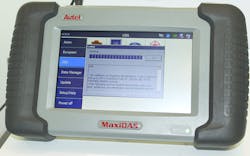Tool Q&A: Need OE scan tool capabilities?
Q: What is the biggest challenge facing independent aftermarket shops in diagnosing OBD II vehicles?
A: Veteran technicians and automotive instructors agree that technicians must understand the capabilities of diagnostic scan tools, which requires training that many shops and technicians currently do not have.
Many OEMs require their dealer technicians to scan all modules for diagnostic trouble codes (DTCs) before any diagnostics or work is performed on the vehicle. The aftermarket shop, however, has to address it on a module-by-module basis. Here is where aftermarket shops run into problems by not fully understanding their scan tool’s capability, according to Peter Orlando, owner of Automotive Training Technologies. How are techs supposed to know up front that a certain vehicle is equipped with 33 modules and their scan tool can only see seven of them?
An aftermarket shop doesn’t have the ability to clear all the codes if the tool can’t draw the right module, Orlando notes. This is why most professional shops have a certain number of OEM scan tools.
“I teach classes up and down the East Coast for many companies,” Orlando says. “I see approximately 60 to 100 technicians a week in my travels and the problems are not in one area or isolated to a specific state. They are universal and many technicians work for employers who want quick answers to provide their customers. This leads to the technicians making assumptions and drawing conclusions against information they don’t have! When the part is ordered and installed in the car and it doesn’t fix the problem, they throw their arms up and say, ‘Well, you wanted an answer, I guessed at what it could be and you won’t give the time I need to troubleshoot it so what do you expect and want me to do?’”
Q: What you see as the most important advantages of the aftermarket scan tools over the OEM scan tools?
A: The aftermarket tools have a variety of capabilities, but they don’t give all the modules of all the vehicles. If the technician understands the full use of the aftermarket tool, they can be beneficial since they do cover a lot of lines. However, the tech has to be properly trained in the use of the aftermarket tool.
Some aftermarket scanners have software built into them to assist the technician in fixing the car, Orlando notes. The software gets updated with new information each time the tool gets updated. The software features many troubleshooting tips, diagnostic procedures, component specifications and “known good” scan tool PID values. Many of the OEM scan tools do not have this type of troubleshooting capability.
The aftermarket shop has to deal with multi-vehicle platforms and systems along with a vast array of different procedures which vary from car line to car line, Orlando says. That’s why some aftermarket scanners are so appealing to shop owners. Such tools have the ability to talk to many car lines, with limitations. It is important to know what these limitations are, which takes us back to the first question posed above.
Every aftermarket scan tool is governed by what they (the tool manufacturer) will buy from the OEM. How does the customer (the technician or shop owner) know how good the content is in the software?
Orlando notes that some aftermarket tool manufacturers “reverse engineer” their scan tool to attempt to replicate the factory scan tool. They fill in the data gaps that the aftermarket scan tool may not provide. What you end up with is a “gap tool.” The aftermarket technician has to learn what tool works on what vehicle by trial and error, or what they can learn from their peers.
Some of these types of scan tools are traditionally inexpensive and are updated for free for a term of one year. Then you have to pay an annual subscription fee. They work pretty well and have decent coverage on the systems they support, Orlando says.
Q: What are the constraints to consider in the generic versus enhanced OE aftermarket scan tools?
A: According to Ed Lipscomb, senior product manager for global diagnostics for global diagnostics at Bosch Automotive Aftermarket, the simplest shortcoming of generic tools is that they only focus on emissions-related powertrain systems with few bi-directional controls and do not cover body and chassis systems.
A generic tool covers all emissions related power train OBD II coverage, modes 1 through 10, whereas an OE-enhanced aftermarket tool provides OEM level data stream, diagnostic trouble codes and bi-directional controls for all supported systems including body, chassis and powertrain, Lipscomb says.
Q: How can one find out if a scan tool does a complete module scan for a certain vehicle?
A: According to Autel, techs should look for information on coverage beyond PCM or engine, ABS, and airbag. These three are usually a focus for most manufacturers. It is coverage beyond them where you see real OE level shine. It is a pretty good bet if a tool has coverage beyond those its coverage in them will be superior. Access to Immobilizer, Skim or PATS is another good sign of coverage.
EASE Diagnostics has ways to show how comprehensive its scan tool is before buying, notes Rich Wilbur, corporate controller. In “Demo” mode, the technician opens the scan tool software to see what modules and data are supported for any chosen vehicle. The “Try Before You Buy” mode allows actual communication with a vehicle using a compatible J2534 interface. This allows the technician to use the scan tool live on any chosen vehicle before purchase.
Q: Do government regulations affect how technicians diagnose vehicles?
A: In some instances, yes, notes Orlando of Automotive Training Technologies. These days, depending on the state you work in, you can’t even clear emission related DTCs unless a repair to the system was made. The OEMs, in cooperation with the U.S. EPA, will not be allowing DTC reset of codes. The system must clear the DTC on its own accord. This will challenge many shops that do not have the proper training and updated equipment to handle these situations.
Q: Some scan tools integrate with repair information services; what is the benefit of this?
A: YouTube, iATN, Identifix, Mitchell 1, Alldata and the Internet are great resources of information, but they are not training sites, veteran techs and instructors agree. They are resources like any other piece of information. The skilled technicians that use these sites know when and how to use these sites. The right information at the right time utilized by a trained technician with the right tools and equipment leads to successful, profitable repairs, satisfied customers, and a great shop reputation.
About the Author

